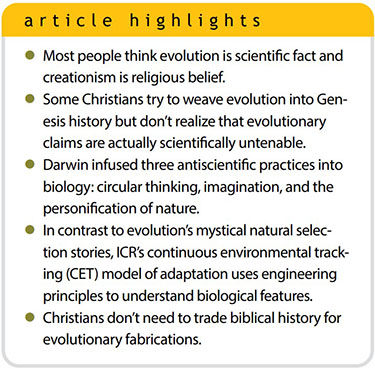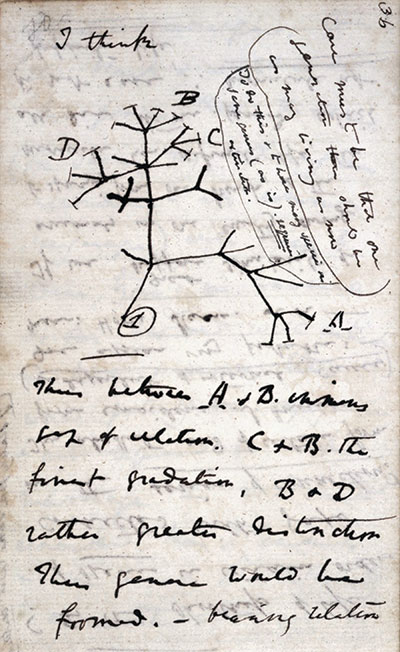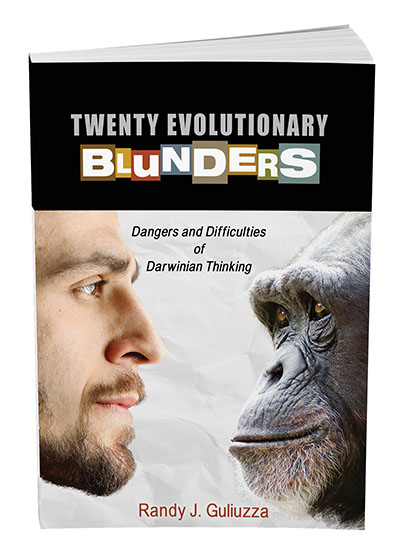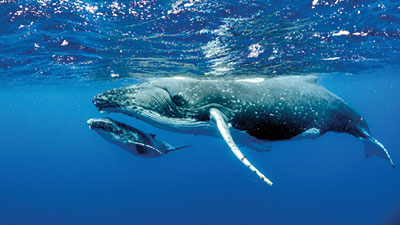 There’s no denying that most people believe evolution is science but creation science and Intelligent Design (ID) are religion. Education, entertainment, news media, and even our government promote the persuasive claim that belief in evolution is objective, rational behavior in contrast to highly subjective, if not irrational, religious thinking. The former is connected to being smart and the latter to lacking intelligence. I suspect that beginning in childhood, one of the biggest fears humans develop is that others will think of them as dumb. As a tool of ridicule, it can enforce widespread social conformity. What a hurdle to overcome. We need to acknowledge its use and respond wisely.
There’s no denying that most people believe evolution is science but creation science and Intelligent Design (ID) are religion. Education, entertainment, news media, and even our government promote the persuasive claim that belief in evolution is objective, rational behavior in contrast to highly subjective, if not irrational, religious thinking. The former is connected to being smart and the latter to lacking intelligence. I suspect that beginning in childhood, one of the biggest fears humans develop is that others will think of them as dumb. As a tool of ridicule, it can enforce widespread social conformity. What a hurdle to overcome. We need to acknowledge its use and respond wisely.
Skeptics have long recognized the power of characterizing Christians as dumb. To make that point, their literature uses quotes such as Mark Twain’s ridicule of Bible believers:
You believe in a book that has talking animals, wizards, witches, demons, sticks turning into snakes, burning bushes, food falling from the sky, people walking on water, and all sorts of magical, absurd and primitive stories, and you say that we are the ones that need help?1
Even some Christians blush over the same biblical accounts Twain scoffed at. One predictable response has been to explain these events away via rhetorical devices. Recently, the noted Christian apologist William Lane Craig, who believes that evolution was God’s way to fashion creatures, tried in his book In Quest of the Historical Adam: A Biblical and Scientific Exploration “to understand the [biblical] text as the original author and his audience would have understood it.”2 Why can’t Craig just interpret Genesis normally? Well, he acknowledged the obvious discrepancies and that something must give—either evolution or parts of the Bible.
For Craig, it’s the Bible. He teaches that Genesis 1–11 is best described as “mytho-history” and not as real historical narrative. He believes the Bible’s opening chapters are riddled with unreal events. These are identified by their “fantastic” elements that reveal them to be mythological. Craig wouldn’t deny God’s miraculous interventions like Jesus’ resurrection, but in his opinion, “fantastic” biblical accounts are those that “if taken literally, are so extraordinary as to be palpably false.”3
Biblical accounts that he’d consider as palpably false are remarkably like Twain’s choices and would include Eden’s talking snake and cherubim with a sword, incredibly long life spans, a global flood, and more.3 Rather than believing that the biblical Adam was directly created by God, Craig invests several hundred pages in trying to identify some evolutionary product as “Adam” and shoehorn it into today’s evolutionary scenario.
Perhaps there’s a better response to evolution than trying to weave it into the biblical narrative or treating it as though it’s the storehouse of rational scientific thought on origins. It’s more effective to point out that the reason why evolutionists pound their pulpits so loudly and fanatically to shut down dissenting views in classrooms is to keep up the smokescreen hiding how scientifically untenable their claims have always been.
Those claims started with Charles Darwin, who infused into biology three antiscientific practices—circular thinking, imagination, and personifications of nature (wholesale magical explanations). These interpretive practices are standard fare in the most elite evolutionary literature, but they actively hinder biological research. It’s time to challenge Darwin’s irrational approach to interpreting biological phenomena.
Circular Thinking Pervades Evolutionary Explanations

Darwin wrote “I think,” not “I observe,” when he first drew his concept of an evolutionary tree. In this speculation, he employed his imagination rather than empirical science.
Darwin’s circular thinking begins right in the title of his seminal work, On the Origin of Species by Means of Natural Selection, or the Preservation of Favoured Races in the Struggle for Life. Darwin’s subtitle is a remarkably succinct key to his theory and everything he was promoting. We’ll consider how it identifies all three of Darwin’s nonscientific insertions into biology. Darwin’s unscientific approach was severely criticized by leading scientists soon after the publication of Origin but has since gone largely unchallenged.4
Circular thinking/reasoning is a logical mistake people make when they assume that what they want to prove is already true. Their argument begins with what it’s trying to end with, hence the name circular. Circular thinking is the easiest of the three antiscientific practices to spot in Darwin’s subtitle the Preservation of Favoured Races in the Struggle for Life. If one were to ask how we know that certain races were favored, the answer is because they were preserved. And if we ask why they were preserved, it’s because they were favored. Thus, Darwin’s subtitle is really saying the Preservation of Preserved Races in the Struggle for Life.A classic example of evolutionary circular thinking is the study of similar traits between creatures, called homology. For instance, one explanation for the similar bones in the legs of a human and a dog is that they utilize a common design. The evolutionary explanation is that they both were inherited from a common evolutionary ancestor. The shared features (in this case, the similar bones) are called homologs. Yet, in circular fashion, the definition evolutionists use for a homolog is a shared feature derived from common ancestry. One evolutionist who observed that circular thinking had even advanced to the point of definition said, “Although ancestry was at first viewed only as an explanation for homology, it soon was incorporated into the definition.”5
ICR paleobiochemist Dr. Brian Thomas researches un-fossilized biological tissues found in dinosaur bones that are claimed to be at least 65 million years old. Though no one has a viable mechanism known to preserve biomolecules for vast ages, evolutionists are convinced long-term preservation did happen. Why? Because they know that dinosaurs died out 65 million years ago. Thomas said:
As a result, the only way to conclude that [an evolutionary] model explains protein persistence for millions of years is to first assume that fossils with proteins still in them have been sitting in the ground for millions of years, thus begging the question.6
Over 30 years ago, one evolutionist pointed out how Darwinian-style circular thinking is antiscientific. He criticized that it is “completely misleading to include” the criteria of common ancestry into the definition of homologous and cautioned:
It becomes obvious that the strategy by which we replace a description of an empirical condition with its explanatory hypothesis is self-defeating….By making our explanation into the definition of the condition to be explained [e.g., similar features], we express not scientific hypothesis but belief. We are so convinced that our explanation is true that we no longer see any need to distinguish it from the situation we were trying to explain. Dogmatic endeavors of this kind must eventually leave the realm of science.7
Imagination: Darwin’s Dream of a “War of Nature”
Again turning to the subtitle of Origin, we see Darwin imagining a terrible “struggle for life.” He closes Origin by saying, “Thus, from the war of nature, from famine and death, the most exalted object which we are capable of conceiving, namely, the production of the higher animals, directly follows. There is grandeur in this view of life.”8
We certainly see predation in the world. But look around— where is the war of nature? Headlines of today’s research read like this: “New Interpretation of Darwin’s Theory: Friendliness and Cooperation Is the Most Successful Strategy in Survival,” “Survival of the Fittest Has Evolved: Try Survival of the Kindest,” “Forget cut-throat competition: to survive, try a little selflessness,” “Survival Of The Nicest? A Theory Of Our Origins Says Cooperation–Not Competition–Is Instinctive,” “What if Competition Isn’t As ‘Natural’ As We Think?”9
The “war of nature” passed on to all of us in our education was just Darwin’s imagination run wild. For years I abandoned my own obligation to make thoughtful observations and passively accepted scientific pronouncements like the war of nature. The fact is that there never has been a war of nature. The ubiquitous and constant cooperative, communal, and symbiotic relationships greatly overwhelm the numbers of fully parasitic and even widespread predator-prey events. Science writer David Coppedge reported on research that found:
The principle of competitive exclusion is not found in “real nature.” The reason probably lies in the fact that ecologists have not questioned some of the principles of evolution. In fact, most ecological models are too simplistic and are often considered outdated. 10

ICR’s book Twenty Evolutionary Blunders documents mistaken evolutionary claims that were the result of overactive imaginations.12 Darwin imagined that whales evolved from a bear-like animal, saying:
I can see no difficulty in a race of bears being rendered, by natural selection, more and more aquatic in their structure and habits, with larger and larger mouths, till a creature was produced as monstrous as a whale.8
Then evolutionists envisioned that whales evolved from a mammal group called mesonychids. But now they imagine that whales evolved from something related to giraffes and camels—despite substantial discrepancies between fossil data and DNA studies.
The Piltdown hoax embarrassed the world’s leading evolutionists, who “discerned” ape features in a human brain case and human features in an ape jaw. Their imagination also snookered them into seeing the perfect transition between dinosaurs to birds in the Archaeorapter hoax. They fancied some DNA as “junk” evolutionary leftovers that later turned out to be vital to cell function. The list goes on.

The most egregious of Darwin’s practices was introducing magical explanations in lieu of objective causes. His subtitle speaks of the Preservation of Favoured Races in the Struggle for Life. Personifications are now so commonplace in selectionist writing that most evolutionists fail to question how there can be “favored races.” Favored by what? Living things with volition and will can favor. But what in unconscious nature is equivalent to a volition that would enable it to exercise favor? This problem isn’t just the figures of speech Darwinists use to attribute agency to nature—it’s their inclusion of nature exercising agency in their causal explanations.
Darwinian selectionists envision a substitute volitional agent selecting for the “fittest” characteristics over time. Thus, to us certain biological features look to be the purposeful effects of an intelligent, volitional agent while to selectionists they’re only the unforeseen outcome of nature “selecting for/against” or “acting on” random mutations. Nature itself is visualized as the volitional, creative agent that replaces God.
Selectionism succumbs to slipping an alternative pseudo-agency into the operation of nature. Darwin cleverly cloaked the pseudo-agency within an analogy that few people spot as illegitimate. However, two prominent atheists, bothered by Darwin’s duplicity, lift the veil:
Familiar claims to the contrary notwithstanding, Darwin didn’t manage to get mental causes out of his account of how evolution works. He just hid them in the unexamined analogy between selection by breeding and natural selection.13
Simply put, breeders have a brain that can make real selections, and nature doesn’t, though Darwinists’ scientific explanations treat nature like it can think.
Some astute evolutionists spot the mystical thinking of selectionism. One evolutionary historian of science concluded that the Darwinian usage of selection “appeared to reify, even to deify, natural selection as an agent.”14 Another evolutionist who recoils from the personification of nature complained that natural selection was always doing something, and thus, “natural selection becomes rather like an occult Power of the prescientific age.”15 Intelligent Design advocate William Dembski called Darwin’s projection of selective ability onto nature “the greatest intellectual swindle in the history of ideas.”16
Mystical thinking continues unabated as the core of evolutionary causality. For instance, in the 1970s many researchers began to interpret evolutionary progression as the outworking of “selfish genes.” Why? Like Darwin, Richard Dawkins, another influential evolutionist, projected agency onto genes themselves, saying that organisms’ bodies are merely “robot vehicles blindly programmed to preserve the selfish molecules known as genes.”17
Clearly though, this prominent selectionist model chokes out real science by appealing to genes exercising numerous agent-like activities (e.g., competition) as an expression of their “selfishness.” A critic of Dawkins’ personification of selfish genes reveals, “The trouble with metaphors is that they don’t just mirror scientific beliefs, they also shape them. Our imagery is never just surface paint, it expresses, advertises and strengthens our preferred interpretations.”18
The eminent evolutionist Ernst Mayr showed how Darwin, Dawkins, and others easily get away with mystical models. Mayr explained that “evolutionary biology, in contrast with physics and chemistry, is a historical science….Laws and experiments are inappropriate techniques” for explaining the past, but “instead one constructs a historical narrative.”19 This subjectivity coupled with unfettered imagination are reasons why the famed evolutionist Richard Lewontin once candidly described evolutionary explanations as “against common sense,” “counter-intuitive,” and “mystifying to the uninitiated.”20
Dawkins portrays himself as a rational atheist standing against superstition. Evidently, all advocates for selfish genes are blind to the magic enveloping their thinking. Perhaps this explains the Wall Street Journal article “Look Who’s Irrational Now” that reported on a Baylor University poll that found that nonreligious skeptics and liberal Christians were far more likely to believe in “Bigfoot, UFOs, haunted houses, communicating with the dead and astrology” than conservative Christians.21
Conclusion
Longtime ICR supporters have expressed appreciation for our non-mystical approach to research. We seek to explain biological functions from a completely objective engineering perspective called engineered biology. Imaginary causes are essentially nonexistent in engineering literature. Our organism-focused, engineering-based continuous environmental tracking (CET) model of adaptation is totally rational and increasingly supported by our cavefish research and even by conventional biologists. It posits that creatures innately self-adjust to changing environments through identifiable sensors, logic pathways, and response mechanisms—without invoking unquantifiable “selection pressures” or imaginary “selection events.”22
Evolutionists claim that actual observations conflict with Genesis being real history. We say that it’s their interpretations of those natural phenomena that conflict with a historical Genesis, and that’s because their anti-engineering approach is inherently flawed. As we’ve seen, the evolutionists' scientific literature has cornered the market on interpretations rooted in self-deluding circular fallacies, extremely fertile imaginations, and ethereal mystical thinking…all the things that they accuse Christians of adopting.
Evolutionists produce a mountain of literature, but it’s filled with imaginative stories and not evidence. Christians needn’t be overawed or intimidated. All of Genesis is real, not mytho-, history, which means that we shouldn’t trade the valuable birthright of God’s historical truth for a bowl of mystical evolutionary pottage.
References
- For example, see Intro to Christianity. Truthful Origins: A Discourse on Evolution and Religion. Posted on truthfulorigins.info.
- Craig, W. L. 2022. In Quest of the Historical Adam: A Biblical and Scientific Exploration. Grand Rapids, MI: William B. Eerdmans Publishing Company.
- Ibid, 104-131.
- Guliuzza, R. J. 2011. Darwin’s Sacred Imposter: Natural Selection’s Idolatrous Trap. Acts & Facts. 40 (11): 12-15.
- Donoghue, M. 1992. Homology. Keywords in Evolutionary Biology. E. F. Keller and E. A. Lloyd, eds. Cambridge, MA: Harvard University Press, 171.
- Thomas, B. 2019. Does the Toast Model Explain Fossil Protein Persistence? Acts & Facts. 48 (3): 10-13.
- Brady, R. H. 1985. On the independence of systematics. Cladistics. 1 (2): 117.
- Darwin, C. 1859. The Origin of Species by Means of Natural Selection. London: John Murray, 429.
- P., E. New Interpretation of Darwin’s Theory: Friendliness and Cooperation Is the Most Successful Strategy in Survival. The Science Times. Posted on sciencetimes.com July 21, 2020; Kukk, C. Survival of the Fittest Has Evolved: Try Survival of the Kindest. NBC News Better. Posted on nbcnews.com March 7, 2017; Dixon, T. Forget cut-throat competition: to survive, try a little selflessness. The Guardian. Posted on theguardian.com July 25, 2016; Johnson, E. M. Survival Of The Nicest? A Theory Of Our Origins Says Cooperation–Not Competition–Is Instinctive. YES! Media. Posted on yesmagazine.org May 3, 2013; Favini, J. What if Competition Isn’t As “Natural” As We Think? Slate. Posted on slate.com January 23, 2020.
- Coppedge, D. F. Darwin and Malthus Were Wrong: Cooperation Is Key to Evolution. Creation- Evolution Headlines. Posted on crev.info May 13, 2016. Quoting from Cooperation, not struggle for survival, drives evolution, say researchers. National Research Tomsk State University news release. Posted on sciencedaily.com May 12, 2016.
- Gould, S. J. 2002. The Structure of Evolutionary Theory. Cambridge, MA: Harvard University Press, 59.
- Guliuzza, R. J. 2017. Twenty Evolutionary Blunders: Dangers & Difficulties of Darwinian Thinking. Dallas, TX: Institute for Creation Research.
- Fodor, J. and M. Piattelli-Palmarini. 2010. What Darwin Got Wrong. New York: Farrar, Straus and Giroux, 62.
- Hodge, M. J. S. 1992. Natural Selection: Historical Perspectives. Keywords in Evolutionary Biology. E. F. Keller and E. A. Lloyd, eds. Cambridge, MA: Harvard University Press, 213.
- Talbot, S. L. Can Darwinian Evolutionary Theory Be Taken Seriously? Posted on natureinstitute. org May 17, 2016, accessed September 14, 2018.
- Dembski, W. A. 2004. The Design Revolution. Downers Grove, IL: Intervarsity Press, 263.
- Dawkins, R. 1976. The Selfish Gene. New York: Oxford University Press, preface.
- Midgley, M. 2011. The selfish metaphor: Conceits of evolution. New Scientist. 2797 (19): 26-27. See also Coppedge, D. F. Metaphors of Evolution. Creation-Evolution Headlines. Posted on crev. info February 1, 2011.
- Mayr, E. Darwin’s Influence on Modern Thought. Scientific American. Posted on scientificamerican. com November 24, 2009, accessed July 6, 2023.
-
Lewontin, R. Billions and Billions of Demons. The New York Review. January 9, 1997. See the full text of Lewontin’s article at drjbloom.com/Public%20files/Lewontin_Rev
iew.htm. - Baylor Survey Finds New Perspectives On U.S. Religious Landscape. Baylor University News. Posted on news.web.baylor.edu September 18, 2008, accessed July 6, 2023. See full text of WSJ article at proteinwisdom.com/?p=13293.
- For more information about continuous environmental tracking, visit ICR.org/CET.
Stage Image: A cinnamon hummingbird feeds from a flower. The bird’s relationship with the flower is clearly symbiotic, not some imaginary fight for survival., Image Credit: Charles J. Sharp CC BY-SA 4.0
* Dr. Guliuzza is President of the Institute for Creation Research. He earned his Doctor of Medicine from the University of Minnesota, his Master of Public Health from Harvard University, and served in the U.S. Air Force as 28th Bomb Wing Flight Surgeon and Chief of Aerospace Medicine. Dr. Guliuzza is also a registered Professional Engineer and holds a B.A. in theology from Moody Bible Institute.





















